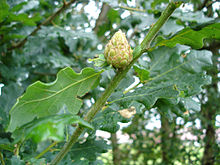- Andricus fecundator
-
Andricus fecundator 
Mature galls on pedunculate oak 
Larva Scientific classification Kingdom: Animalia Phylum: Arthropoda Class: Insecta Order: Hymenoptera Family: Cynipidae Genus: Andricus Species: A. fecundator Binomial name Andricus fecundator
(Hartig, 1840)Oak artichoke galls, oak hop galls, larch-cone galls or hop strobile[1][2] develop as a chemically induced distortion of leaf axillary or terminal buds on Pedunculate Oak (Quercus robur) or Sessile Oak (Quercus petraea) trees, caused by the parthenogenetic gall wasp Andricus fecundator, which lays single eggs within leaf buds using their ovipositor. The larva lives inside a smaller hard casing inside the artichoke and this is released in autumn. The asexual wasp emerges in spring and lays her eggs in the oak catkins. These develop into small oval galls which produce the sexual generation of wasps.[3][4] A yew artichoke gall caused by the fly Taxomyia taxi also exists, but is unrelated to the oak-borne species. Previous names or synonyms for the species A. fecundator are A. fecundatrix, A. pilosus, A. foecundatrix, A. gemmarum, A. gemmae, A. gemmaequercus, A. gemmaecinaraeformis and A. quercusgemmae.
Contents
Galls
Young galls exhibit a tuft of long hairs protruding from the centre of the 'artichoke', the remainder being overlapping scales. The hairs are attached to the more solid gall which is released and drops to the ground from August onwards. After August the 'gall' is still visible, but it is really just the distorted leaf bud after the gall has fallen. A well grown specimen can be 2.0 cm long, dark green or russet, generally developing in June and reaching its full size before autumn.
The hairy catkin galls are oval, pointed, unilocular and unilarval structures, 0.3 cm long, changing colour from pale green to brown. The hairs are whitish in appearance.[1] The wasps of the sexual generation are sometimes known by the synonym Andricus fecundator forma pilosus (DvL 1982).[5]
The gall wasp which emerges from the gall chamber in Spring will always be an asexual female. But she will proceed to lay eggs on oak catkins, with a preference for Q. robur over Q. petraea, which develop into 'hairy catkin galls'.[1][6] The Oak artichoke gall is more common on bush or scrub than tree oaks.
Life cycle
The wasps emerging from the oak artichoke galls will be female; and these females will go on to lay a solitary egg in the male flowers of the oaks, which will cause the formation of the 'hairy catkin galls.' The flies that arise form these galls are of both sexes and the cycle then starts again after they have mated and eggs are laid in the oak buds.[1]
Once the oak artichoke gall has fallen to the ground the imago may leave the gall in the following spring or may delay the emergence for 2–3 years. Galls may persist and exhibit opened scales curving outwards.[7]
Gall-forming insects
Some herbivorous insects therefore create their own micro-habitats by forming usually highly distinctive plant structures called galls, made of plant tissue but controlled by the insect. Galls act as both the habitat, and food sources for the maker of the gall. The artichoke gall is formed entirely from the bud, composed of nutritious starch and other tissues. Some galls act as "physiologic sinks", concentrating resources in the gall from the surrounding plant parts.[8] Galls may also provide the insect with physical protection from predators.[9]
Predators, inquilines and parasitoids
Mature galls are sometimes broken open by vertebrate predators to recover the larva or pupa.
A number of insect inquilines live harmlessly within the oak artichoke gall and some of these, as well as Andricus itself, are parasitised by insects referred to as parasitoids. Some fungi may infect and kill the A. fecundator larvae.
Andricus curvator, the causative agent of the 'collared-bud gall' shows a marked preference for depositing its eggs on buds already colonised by A. fecundator. This may represent an early phase in the development of the inquiline mode of life.[1]
Infestations
Removing and destroying oak artichoke galls before they dry and the wasps emerge may help to reduce the infestation. While fairly large, and sometimes present in quite large numbers on scrub specimens, they cause no measurable harm.
See also
- Gall
- Gall wasp
- Oak apple
- Oak marble gall
- Alder tongue gall
- Knopper gall
- Rose bedeguar gall
- Pineapple gall
- Rhabdophaga rosaria
- Eriophyes tiliae
References
- ^ a b c d e Arnold Darlington (1975). The Pocket Encyclopaedia of Plant Galls in Colour. Poole, Dorset: Blandford Press. pp. 156–157. ISBN 0-7137-0748-8.
- ^ A Nature Observer's Scrapbook
- ^ Galls on UK Safari
- ^ The Virtual Filed Guide UK
- ^ Gall wasps
- ^ Stubbs, F. B. Edit. (1986) Provisional Keys to British Plant Galls. Pub. British Plant Gall Society. ISBN 0-9511582-0-1. P. 46.
- ^ Redfern, Margaret & Shirley, Peter (2002). British Plant Galls. Identification of galls on plants & fungi. AIDGAP. Shrewsbury : Field Studies Council. ISBN 1-85153-214-5. P. 406
- ^ Katherine C. Larson and Thomas G. Whitham (1991). "Manipulation of food resources by a gall-forming aphid: the physiology of sink-source interactions". Oecologia 88 (1): 15–21. doi:10.1007/BF00328398. JSTOR 4219748.
- ^ Arthur E. Weis and Audrey Kapelinski (1994). "Variable selection on Eurosta's gall size. II. A path analysis of the ecological factors behind selection". Evolution 48 (3): 734–745. doi:10.2307/2410482. JSTOR 2410482.
External links
- "Gall". Infoplease encyclopedia. http://www.infoplease.com/ce6/sci/A0820047.html. Retrieved March 2006.
- A photograph of a section through an artichoke gall
- A photograph of an adult fly
Categories:- Cynipidae
- Oak galls
- Animals described in 1840
Wikimedia Foundation. 2010.




